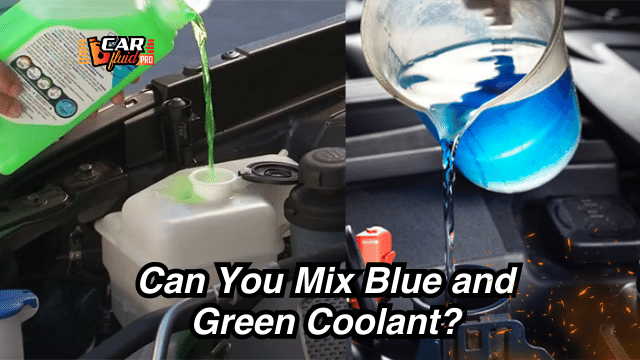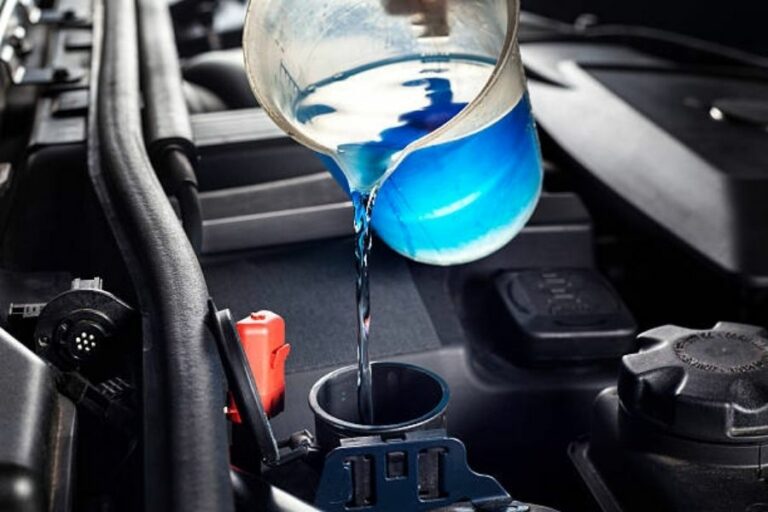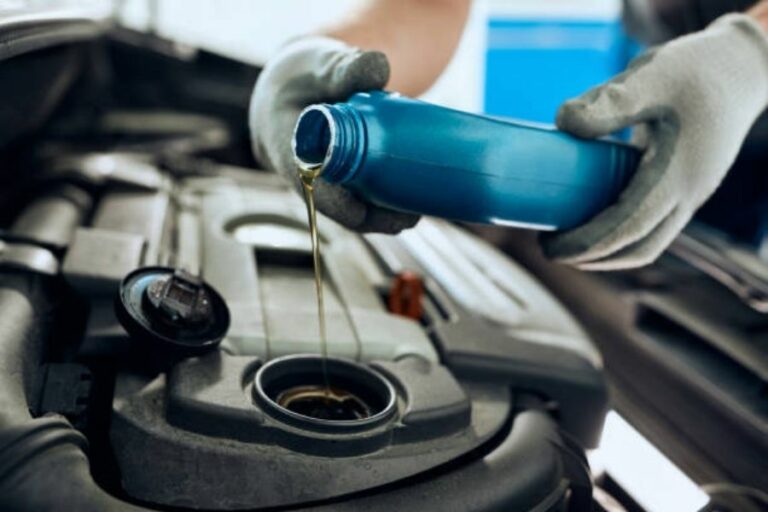Can You Mix Orange And Green Antifreeze?(Don’t Do It)
Coolants or antifreeze ensure the proper functioning of a car engine. It protects the car engine from overheating. Moreover, coolant doesn’t freeze at low temperatures. They come in different colors, including orange, green, red, yellow, etc. So, one question might have popped into your mind, can you mix orange and green coolant?
Before mixing two different-colored coolants, you first need to know their type. You can mix 2 coolants only when they are the same type. Green coolants use IAT (Inorganic Additive Technology). On the other hand, orange coolant depends on OAT (Organic Acid Technology). It means green and orange coolants are different in type and can’t be mixed.
In this guide, I will share a more in-depth discussion about not mixing different coolant types. Also, you will learn what dangers can happen if you do so.
So, let’s jump right in.
What are the Uses of Orange and Green Coolants?
Coolant formula has been developed and advanced over the last couple of years. Before getting into the topic, let’s learn more about green and orange coolants from below.
Green Coolant
The green coolant is IAT or G11 type. Its composition is similar to G12, but carboxylic acids are unavailable in G11. Green antifreeze has 2 years of lifespan and is suitable for older or classic cars. Therefore, changing intervals are frequent.
Phosphate and silicone are used in IAT coolant products. These components combine with ethylene glycol and propylene glycol, keeping the car cooling system at its best.
Car engines that are built prior to the year 2000 have steel or copper construction. Green coolant prevents corrosion build-up from these materials effectively.
The phosphate of green coolants properly seals metal parts to remove the formation of oil and grease from cooling system components. Meanwhile, silicone reduces the regular wear and tear of metal parts.
Propylene and ethylene glycol are crucial components in green or IAT-based coolants. These 2 chemicals are responsible for keeping the car engine cool when running.
Orange Coolant
Orange coolant is G12 or Organic Acid Technology type. The composition depends on additives (nitrites, borates), water, and ethylene glycol. Additionally, it includes carboxylic acids as well. This coolant has a lifespan of a maximum of 5 years and can be used on all modern cars like VW and GM.
Moreover, Dex-cool is a commonly used compound in OAT antifreeze. This compound is orange-colored, which is why car owners call it orange coolant.
Generally, luxury and modern vehicle engines are made of fewer metal parts. Most components of these engines are made of nylon and aluminum.
Carboxylate is another vital ingredient of OAT or orange coolants. This ingredient fights against corrosion. As a result, orange coolants keep the aluminum and nylon parts durable for many days.
Although they offer 5 years of efficient service, it is better to check the orange coolant every 50,000 miles.
Can You Mix Orange and Green Coolant?
As you already understand, orange and green coolants are different. If you mix them and use them in the vehicle, significant damage will happen to your car.
So, the short answer is you can’t mix orange and green coolant.
What Happens If I Mix Orange And Green Antifreeze?
Green coolants are formulated following older technology. Also, it consists of inorganic additives, allowing it to be changed more often.
On the other hand, orange coolants are manufactured with IAT technology. These are suitable for newer vehicles that are made after 2000.
Mixing 2 different coolant types and pouring them into your vehicle will surely damage your car engine and coolant system. Your vehicle engine can overheat, causing permanent damage to the car.
That is why it is always best to use your car coolant system-compatible coolant. Moreover, reading the manufacturer’s manual is recommended before changing and choosing a coolant or antifreeze for your vehicle.
Dangers of Mixing Orange and Green Coolant
Well, the consequence of mixing orange and green coolant is terrible.
After mixing them, the liquid will create a jelly-like mixture which will clog the coolant system and narrow passageways. This way, the coolant will be unable to complete its job, resulting in frequent engine maintenance.
At the same time, due to the clog, the engine starts overheating. Undoubtedly, engine overheating is not a good thing at all.
When your car engine is unable to cool down, engine burnout will become a common thing.
So, avoid mixing green and orange coolant and pouring it into the coolant reservoir.
Even if your coolant doesn’t overheat, don’t think no complications exist. In reality, orange-green coolant can ruin your car’s water pumps, thermostats, water jackets, and other crucial components.
Here are some dangers of mixing orange and green coolants.
Engine Overheating
The orange-green coolant mixture will not perform at its best, so your car engine will overheat.
Due to an overheated engine, the pistons and cylinder walls will deform, bend and warp. This way, a perfect seal will happen between the engine and the piston. Finally, the engine will lose its integrity.
Another complication that may appear because of overheating is engine knocking or detonation.
Difficult Starting
When orange and green coolant is mixed, the lubrication becomes a jelly-like substance. This substance clogs the passageways of engine components. Thus, coolant can’t flow in the required parts. Moreover, oil flow hampers.
For this reason, the engine loses power and becomes less responsive. In addition, you will face difficulty in starting your car. Besides, emissions of the harmful gas will increase.
Marred Hoses
Orange and green are completely different types of antifreeze. When they are blended, they will start expanding. Thus, pressure increases inside the hoses.
Because of the excessive pressure, the hoses may burst and get disconnected from the car radiator or engine.
Such a problem needs to be handled by a professional mechanic. Also, the repair cost of this complication is high.
So, it can be said that,
Mixing 2 improper coolants can cause metal contamination, silicate drop-out, and reduction of inhibitors. Also, corrosion and rust will appear in the liquid system, causing component failure.
Are Green And Orange Coolant Interchangeable?
No, green and orange coolant are not interchangeable. Each type of coolant has a different chemical composition that is optimized for a specific engine type.
For example, green coolant is typically used in engines with cast iron components, while orange coolant is used in aluminum engines.
Switching between coolants can cause corrosion and other problems. It’s important to use the correct coolant for your engine to prevent damage and keep it running properly.
What to Do if You Mix Incompatible Coolants?
Did you already mix and pour incompatible coolants into your vehicle? If the answer is yes, worry less because every problem comes with a solution.
In this case, prompt action is a must. The mixture should only be allowed in the cooling system for a short time. This will cause more damage to your car engine.
Therefore, call a professional mechanic. They are the best person to help you get out of the problem and determine what needs to be done next.
Most automotive mechanics suggest towing the car to its location. This way, the mixture will be unable to do further damage to the engine. Driving with the wrong coolant mixture is also prohibited. Take a schedule from a mechanic shop that offers mobile service to your home.
A professional mechanic will flush out the coolant thoroughly from the system. Then they will ensure the mixture is removed before turning your engine on.
Next, they will inspect the engine and coolant system for possible damages to the radiator and cooling pump. If they find any damage, these components need to be replaced.
Once all repairs are done, the mechanic will pour the manufacturer-recommended coolant into your car.
What Coolant Can You Mix with Orange Coolant?
First, it is important to note that coolant colors can’t decide whether they can be mixed with other antifreeze.
Before mixing orange coolants with others, you must know their formula. Mixing can be done if the orange coolant formula and other coolant technology are the same.
Coolants that use Organic Acid Technology (OAT) can be blended with orange antifreeze. Are you wondering what color OAT coolants are? Organic Acid Technology coolants come in purple, yellow, pink, and dark green colors.
What Coolant Can You Mix with Green Coolant?
There are some situations when a car owner has no choice except to mix one coolant with other types. The first condition before mixing it with other antifreeze is learning about the coolant formula.
Green coolant depends on the G11 formula or Inorganic Additive Technology. Mixing is only allowed when the same formula makes the coolant types.
With this point, mixing G11 or IAT coolant is allowed with coolant that formulates with the same formula. Otherwise, mixing is prohibited. These days, IAT coolant comes in the color yellow or the color green.
What Color Antifreeze Can Be Mixed?
If you’ve ever looked under your car’s hood, you’ve probably noticed the bright green liquid in the radiator.
This green liquid is antifreeze, and it plays a vital role in keeping your car running smoothly during the hot summer months and the cold winter months.
But what happens if you need to add some antifreeze to your radiator and all you have is red antifreeze?
Can these two different colors of antifreeze be mixed? The answer is yes, you can mix red and green antifreeze together.
In fact, most auto manufacturers produce a universal antifreeze that is compatible with both color types.
However, it’s important to note that mixing different colors of antifreeze can result in a slight decrease in performance. Therefore, it’s always best to use the same color of antifreeze that is already in your radiator.
Read More About: What is Dexcool
What is the Difference between Green And Orange Antifreeze?
There are a few key differences between green and orange antifreeze. The most obvious difference is the color, but there are also differences in the ingredients and how they work.
Green antifreeze is usually made with propylene glycol, while orange antifreeze is made with ethylene glycol.
Propylene glycol is less toxic than ethylene glycol, so it’s safer to use if there’s a chance of leakage into the environment.
However, propylene glycol isn’t as effective at preventing freezing, so it’s not always the best choice for very cold climates.
Orange antifreeze also typically has a higher boiling point than green antifreeze, which means it can better withstand overheating.
This can be important in hot weather or when driving at high speeds for long periods of time. Overall, both green and orange antifreeze have their advantages and disadvantages.
It’s important to choose the right type of antifreeze for your climate and driving habits to ensure your car stays in good condition all year round.
Orange Coolant Vs Green
When it comes to coolant, there are two main types that you will find on the market today – orange and green.
Both have their own set of benefits and drawbacks, so it’s important to know which one is right for your car before making a purchase.
Here’s a closer look at the pros and cons of each type:
Orange Coolant Pros
Orange coolant is typically cheaper than green coolant. It also has a higher boiling point, which means it can better protect your engine from overheating.
Orange Coolant Cons
One downside of orange coolant is that it doesn’t last as long as green coolant – you may need to top it up more often. Additionally, some people find the smell of orange coolant to be unpleasant.
Green Coolant Pros
Green coolant has a longer lifespan than orange coolant, so you won’t need to top it up as often. It also doesn’t have as strong of a smell, making it more pleasant for many people.
Finally, green coolants tend to provide better protection against corrosion and deposits.
Also Read: Hoat Coolant
How Long Can You Drive With Mixed Coolant?
If your car’s coolant levels are low, you may be tempted to just add water to the radiator. However, this can actually cause more harm than good.
Water doesn’t have the same properties as coolant, and can actually rust and corrode parts of your engine.
It’s best to mix coolant with water in a 50/50 ratio so that you don’t damage your engine. But how long can you drive with mixed coolant? The answer isn’t quite so simple.
It depends on a number of factors, including the type of coolant you’re using and the temperature outside. In general, though, it’s best to get your car to a mechanic as soon as possible so they can check the coolant levels and top off the reservoir if necessary.
If you do find yourself in a situation where you need to mix coolant with water, make sure to use distilled water. This will help prevent any minerals or impurities from damaging your engine further.
Can You Mix Coolant Colors?
There’s a common misconception that you shouldn’t mix coolant colors. The reality is, it’s perfectly fine to mix coolant colors as long as you’re using the same type of coolant.
For example, if you’re using an ethylene glycol based coolant, it won’t matter what color it is because they’ll all mix together just fine.
However, if you’re trying to mix a propylene glycol based coolant with an ethylene glycol based one, that’s when you could run into problems.
The reason why there’s this confusion is because some companies produce different types of coolants for different engine applications.
For example, Caterpillar produces a yellow antifreeze for their on-highway trucks and a red antifreeze for their off-highway vehicles.
If you were to put the two together, it would cause corrosion and scale build-up in the cooling system which could lead to expensive repairs down the road.
So, can you mix coolant colors? Yes, as long as they’re both the same type of coolant.
Just be sure to check with your manufacturer or dealer to find out what type of coolant is recommended for your vehicle before mixing any together.
Can You Mix Orange And Yellow Coolant?
It’s a common question among car owners: can you mix orange and yellow coolant? The answer is yes, you can mix the two colors of coolant without any issues.
However, it’s important to note that mixing different types of coolant can cause problems down the road.
So, if you’re going to mix coolants, be sure to use the same type of coolant in both your car and your radiator.
Orange Coolant Brands
If you’re like most people, you probably don’t think much about the coolant in your car. But did you know that there are different types of coolant, and that some are better than others? If you’re looking for an orange coolant, there are a few brands that stand out.
Here’s a look at three of the best orange coolant brands on the market:
Zerex G-05 Antifreeze/Coolant
This orange coolant is designed for use in both European and Asian vehicles, and it’s compatible with all major antifreeze/coolant technologies. It provides excellent corrosion protection and helps to keep your engine running cooler.
Prestone AF2000 Antifreeze/Coolant
This is another great option for those who own European or Asian vehicles. It’s also compatible with all major antifreeze/coolant technologies and provides excellent corrosion protection.
Valvoline Zerex Asian Vehicle Antifreeze/Coolant
This orange coolant is specifically designed for use in Asian vehicles, and it’s compatible with all major antifreeze/coolant technologies.
It helps to keep your engine running cooler and provides excellent corrosion protection.
Final Words
I believe you are now clear with the answer to the question: can you mix orange and green coolant?
It is not recommended to blend 2 different types of coolants. Orange and green coolants are made using different formulas. So, mixing them is disallowed.
But there are some exceptions when you have to mix 2 coolants. In this case, it is crucial to know the factors. Mixing is only allowed for the same type of antifreeze during an emergency. If you don’t do so, you are welcoming severe engine damage and expensive repairs.






![Can You Mix Prestone Antifreeze With Dexcool? [Compatibility]](https://carfluidpro.com/wp-content/uploads/Can-You-Mix-Prestone-Antifreeze-With-Dexcool-768x512.jpg)